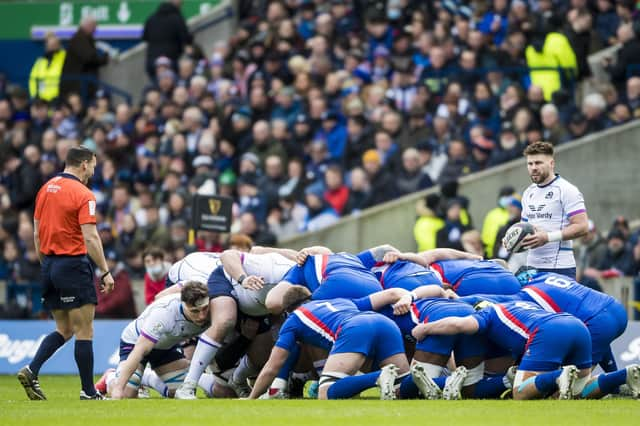The scrum is a problem for rugby - lawmakers now face a crucial choice


It’s not a fair contest because the law requiring the ball to be put in straight is ignored. It is more and more seen as a means of winning a penalty rather than re-starting the game and, as used to be both theory and practice, getting the ball to the backs while forwards are, for the moment at least, out of the way.
All these objections are reasonable. Can suitable answers be found?
Advertisement
Hide AdAdvertisement
Hide AdFirst the set-up and engagement with the referee shouting out instructions. Sometimes he or she is not satisfied and it has to be done again. This gradual set-up was brought in for safety reasons: to prevent a mighty collision as each scrum sought to get the upper hand. Well ,this was laudable. Nevertheless, it’s unsatisfactory.
When I coached schoolboys decades ago, we had them doing this by numbers: first the front-row engage with no movement forward or back, then the second row and then the No 8. Do it like this and there is no collision, or, if there is, it is easily spotted and penalised.
Second, the put-in. Referees insist (once or twice in a match anyway) that the ball is thrown in straight at the line-out, but they have given up on the set scrum. There was a brief flurry a few years ago when referees penalised at least one squint put-in a match – one remembers the horrified indignation on Ali Price’s face when he was penalised for a squint put-in at a defensive 5-metres scrum in Cardiff – but the law was soon ignored again. Some say that it is now too dangerous, given the power of scrums, for hookers to strike for the ball, and this may be true. Consequently, the ball is now usually fed straight into the second row (as in Rugby League scrums) and the hooker doesn’t have to hook.
Things would be different, howeve,r if the loose-head props were required to have their outside foot ahead of the other when they scrummed down as used to be the case. Now it is usually ahead of the inner foot, and this enables the loose-head to scrum destructively pushing inwards to separate the opposing prop and hooker. A penalty often results in his favour because his immediate opponent, under-pressure, has broken or slipped his bind.
So we come to the third point, the scrum being seen as a means of winning a penalty. It is now more usual for a scrum to end in a penalty than in a pass from scrum-half to stand-off. Very few ever spectators know why the penalty has been awarded. It is even quite common for experts in the commentary box to be mystified or n say the penalty has gone the wrong way. This is unsatisfactory.
Sometimes the ball is held in the back-row while the stronger scrum advances till the weaker one collapses and is penalised for not being sufficiently strong. This seems unfair. Sometimes the penalty comes when the pack not in possession wheels the scrum and is rewarded with the penalty. Neither of these penalties seems justifiable, for in both cases the dominant scrum has already gained a possible advantage. It has go-forward ball in the first instance, while, in the second the wheeling scum opens up an advantage to the side in possession. There is another objection to these penalties at the scrum, and it seems to me a compelling one .A scrum follows an unintentional error – a knock-on, forward pass, accidental offside or when the ball becomes unplayable at the tackle point. As long as the scrum is seen merely as a means of restarting the game by, often, exchanging possession, this is fine. But when the scrum results in a penalty as so many, even the majority, often do, the inadvertent error is punished heavily. It is often the case that a penalty goal is kicked, which in effect means that a knock-on has cost your side three points, or the kicker goes for the corner and then a maul from the line-out leads to a try being scored. Very evidently the way that the scrum is refereed now means that the punishment for a minor accidental offence cannot be said to fit the original crime.
So there’s a choice for the lawmakers. Either revise the scrum laws and do so intelligently and sympathetically, or the public get so fed up with the time taken by scrum and their unfair influence on the game that there is a demand to reduce them to the level of Rugby League scrums, or even get rid of them altogether. Either would be a pity, because the Rugby Union scrum is an integral part of the game. But the way it is now policed and judged is damaging the game and is often both unfair and absurd.